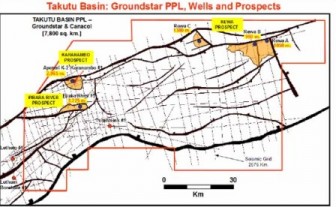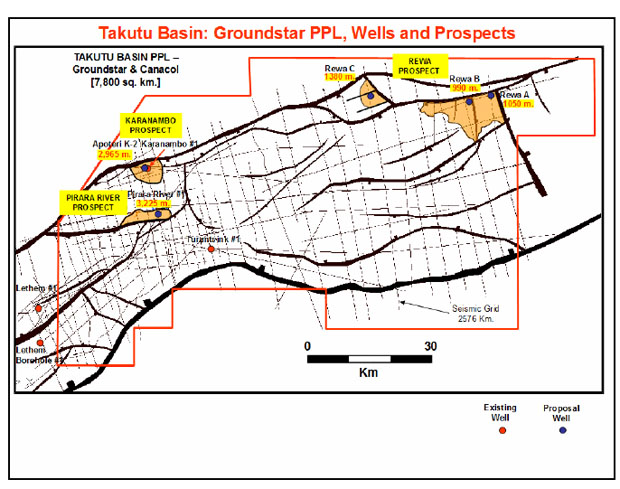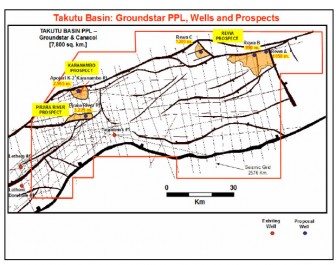Canadian explorer Groundstar is to abandon its Apoteri, Rupununi drill site after reaching the intended depth and seeing no signs of oil in commercial quantities, a press release said today.
Groundstar Resources Limited had been exploring at the Apoteri K-2 exploration well located in the Takutu Basin.
A Market Wire release today said that over the course of the next week the Apoteri K-2 well will be abandoned. The consortium is currently evaluating the next exploration drilling location on the block.

“Based upon the gas and oil shows and log interpretation, drill stem tests (DSTs) have been conducted to date as follows in measured depths:
- DST 1 (Manari-Apoteri): 2,445 to 2,571 metres, misrun;
- DST 2 (Manari-Apoteri): 2,445 to 2,571 metres, recovered 20 metres drilling mud, reservoir was tight;
- DST 3 (Apoteri): 2,656 to 2,799 metres, recovered 73 metres drilling mud from low permeability reservoir;
- DST 4 (Apoteri): 2,897 to 2,991 metres, recovered 2,300 metres of formation salt water from a high permeability fracture zone at 2,976 metres.
“Although excellent reservoir quality was encountered in this interval of the Apoteri Formation, the reservoir appears to have been penetrated below the oil – water contact, defined by the interval of good oil and gas shows between 2,515 and 2,841 metres.
“Over the course of the next week the Apoteri K-2 well will be abandoned. The consortium is currently evaluating the next exploration drilling location on the block.”
On April 20, Stabroek News had reported that the delay in releasing results of the first well had seen Canacol Energy Inc’s stock drop towards the lowest closing price in seven months.
Canacol holds the largest interest in the first well, the Apoteri K-2. It continues to drill and test the well, Kevin Flick, head of investor relations for the company told Bloomberg on April 19. Flick had earlier told Stabroek News that they will be reporting the results to the market and noted that the well is quite material to them as a public company.
A Region Nine official had told this newspaper on April 19 that while there had been no firm results from the first well, the consortium had applied for permission to drill a second well.
Canada-based Groundstar Resources Inc has a 10% working interest in the Apoteri K-2 well and is the operator of the Petroleum Prospecting Licence with Canacol holding the remaining 90%. Sagres Energy Inc. is eligible to earn a 25% working interest in the PPL from Canacol by paying for 30% of the cost to drill the K-2 exploration well. Drilling had started on December 31 last year.
The consortium had reported earlier this year that plans for a second exploration well on the block by May 2011 are underway, with the choice of prospect (either the Rewa or the Pirara River) dependent on drilling results from Apoteri K-2. The second well will be operated by Canacol; Groundstar will be carried for a 10% net interest.
The dry well is the latest disappointment in Guyana’s quest to find oil in commercial quantities. Another explorer, Home Oil had sunk a well in the same area in 1982 but while oil was found it was not evident in commercial quantities. Home Oil had discovered high quality crude oil in the fractured Lower Jurassic Apoteri volcanic and Manari sedimentary reservoirs in the Karanambo #1 well and this was seen as proof that the rift basin had an active petroleum system and the commercial oil could exist in the basin
During the January launching ceremony for the Groundstar operation, Agriculture Minister Robert Persaud had referred to this. Performing the duties of the Prime Minister, he had noted that oil had previously been discovered at Karanambo, though not in commercial viable quantities, and this “gives us hope.” He had pointed out that by the second half of this year, Guyanese will see rigs both on land and in the sea which he stated is a good sign. Another Canadian oil exploration company, CGX Energy, is expected to begin drilling in the Corentyne in the second half of this year.
CGX’s oil exploration rig had been chased out of Guyana’s waters in 2000 by Suriname gunboats and this led to a protracted dispute which prevailed until Guyana took its case to the International Law of the Sea Tribunal in Hamburg, Germany and won. The ruling handed down in September 2007 cleared the way for a resumption of offshore drilling in the area and CGX is likely to resume exploring in this area after extensive re-assessing of data. Several oil drilling efforts on land by CGX in the Berbice area came up dry prior to 2007.
In the 1990s US company Hunt Oil also came up dry in the Rupununi area as did French explorer TOTAL offshore Guyana.






